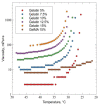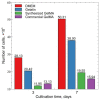Properties and Printability of the Synthesized Hydrogel Based on GelMA
- PMID: 36768446
- PMCID: PMC9917366
- DOI: 10.3390/ijms24032121
Properties and Printability of the Synthesized Hydrogel Based on GelMA
Abstract
Gelatin methacryloyl (GelMA) has recently attracted increasing attention. Unlike other hydrogels, it allows for the adjustment of the mechanical properties using such factors as degree of functionalization, concentration, and photocrosslinking parameters. In this study, GelMA with a high degree of substitution (82.75 ± 7.09%) was synthesized, and its suitability for extrusion printing, cytocompatibility, and biocompatibility was studied. Satisfactory printing quality was demonstrated with the 15% concentration hydrogel. The high degree of functionalization led to a decrease in the ability of human adipose-derived stem cells (ADSCs) to adhere to the GelMA surface. During the first 3 days after sowing, proliferation was observed. Degradation in animals after subcutaneous implantation was slowed down.
Keywords: GelMA; biocompatibility; cytocompatibility; extrusion 3D bioprinting; hydrogel.
Conflict of interest statement
The authors declare no conflict of interest.
Figures








References
-
- Annabi N., Tamayol A., Uquillas J.A., Akbari M., Bertassoni L.E., Cha C., Camci-Unal G., Dokmeci M.R., Peppas N.A., Khademhosseini A. 25th Anniversary Article: Rational Design and Applications of Hydrogels in Regenerative Medicine. Adv. Mater. 2014;26:85–124. doi: 10.1002/adma.201303233. - DOI - PMC - PubMed
-
- Isaeva E.V., Beketov E.E., Demyashkin G.A., Yakovleva N.D., Arguchinskaya N.V., Kisel A.A., Lagoda T.S., Malakhov E.P., Smirnova A.N., Petriev V.M., et al. Cartilage Formation In Vivo Using High Concentration Collagen-Based Bioink with MSC and Decellularized ECM Granules. Int. J. Mol. Sci. 2022;23:2703. doi: 10.3390/ijms23052703. - DOI - PMC - PubMed
MeSH terms
Substances
LinkOut - more resources
Full Text Sources

